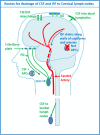Clearance of interstitial fluid (ISF) and CSF (CLIC) group-part of Vascular Professional Interest Area (PIA), updates in 2022-2023. Cerebrovascular disease and the failure of elimination of Amyloid-β from the brain and retina with age and Alzheimer's disease: Opportunities for therapy
- PMID: 37897797
- PMCID: PMC10917045
- DOI: 10.1002/alz.13512
Clearance of interstitial fluid (ISF) and CSF (CLIC) group-part of Vascular Professional Interest Area (PIA), updates in 2022-2023. Cerebrovascular disease and the failure of elimination of Amyloid-β from the brain and retina with age and Alzheimer's disease: Opportunities for therapy
Abstract
This editorial summarizes advances from the Clearance of Interstitial Fluid and Cerebrospinal Fluid (CLIC) group, within the Vascular Professional Interest Area (PIA) of the Alzheimer's Association International Society to Advance Alzheimer's Research and Treatment (ISTAART). The overarching objectives of the CLIC group are to: (1) understand the age-related physiology changes that underlie impaired clearance of interstitial fluid (ISF) and cerebrospinal fluid (CSF) (CLIC); (2) understand the cellular and molecular mechanisms underlying intramural periarterial drainage (IPAD) in the brain; (3) establish novel diagnostic tests for Alzheimer's disease (AD), cerebral amyloid angiopathy (CAA), retinal amyloid vasculopathy, amyloid-related imaging abnormalities (ARIA) of spontaneous and iatrogenic CAA-related inflammation (CAA-ri), and vasomotion; and (4) establish novel therapies that facilitate IPAD to eliminate amyloid β (Aβ) from the aging brain and retina, to prevent or reduce AD and CAA pathology and ARIA side events associated with AD immunotherapy.
Keywords: ARIA; IPAD; ISTAART; amyloid; cerebrospinal fluid; clearance; interstitial fluid.
© 2023 The Authors. Alzheimer's & Dementia published by Wiley Periodicals LLC on behalf of Alzheimer's Association.
Conflict of interest statement
R.A. is a full‐time employee and shareholder of F. Hoffmann‐La Roche Ltd. All other authors declare no conflicts of interest. Author disclosures are available in the supporting information.
Figures



References
-
- Hawkes CA, Gentleman SM, Nicoll JA, Carare RO. Prenatal high‐fat diet alters the cerebrovasculature and clearance of β‐amyloid in adult offspring. J Pathol. 2015;235(4):619‐631. - PubMed
Publication types
MeSH terms
Substances
Grants and funding
LinkOut - more resources
Full Text Sources
Medical

